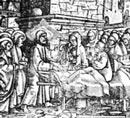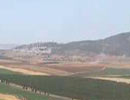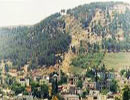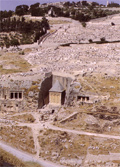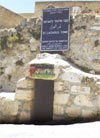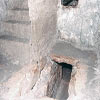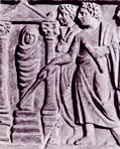Dawn of the Dead?
"And the graves were opened; and many bodies of the saints which slept arose,"
– Matthew 27.50.
Not a verse that gets much attention from the "historical Jesus" school.Ancient Jewish lore said that the Lord would split open Mount Olivet and the righteous dead would rise.
This scenario crept into Matthew 27 but the other evangelists prudently ignored this challenging "historical event".
Miracle at Nain?
In the Christian dreamscape, JC raises a widow's son. What perhaps should ring alarm bells is that this story had been used before – repeatedly!
Hill of Moreh, south side (Shunem). Elisha raises the dead son – the only child – of an old woman (2 Kings 4.32,35).
Hill of Moreh, north side (Nain). Jesus raises the dead son – the only child – of an old woman (Luke 7.11,15).
Tombs R Us
A view looking across the Kidron Valley from Temple Mount to the Mount of Olives. The hillside is a vast cemetery, complete with many elaborate tombs.
Lazarus, come forth!
Tourists, this way!
Bethany, (on the eastern slope of Mount Olivet, a little over a mile from the Old City of Jerusalem) has a suitable "Lazarus tomb" to attract the tourists. This "tomb entrance" was built by Franciscan monks at the end of the 16th century.
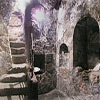
Steps lead down to a large ante-chamber, modified by crusaders.
The tomb of Lazarus – well someone's tomb.
Tomb Raider
Notice that the Lazarus "tomb" depiction on this 3rd century sarcophagus features an Hellenic style tomb and a corpse wrapped in the style of an Egyptian mummy – not what might be expected for a Judaean peasant (and not exactly the Turin shroud!).
Jesus, in Roman toga, waves his magic augur's wand.
History or myth?
Josephus' "Lazarus" rescued from "death"
"There was a certain young man among the besieged, of great boldness ... his name was Eleazar ... Now a certain person belonging to the Roman camp ... ran upon him suddenly, when nobody expected such a thing, and carried him off ...
So the general of the Romans ordered that he should be taken up naked, set before the city to be seen, and sorely whipped before their eyes. ... he commanded them to set up a cross, as if he were just going to hang Eleazar upon it immediately;
The sight of this occasioned a sore grief among those that were in the citadel ... so they now yielded to their passion ... treated with the Romans, in order to surrender the citadel to them, and desired that they might be permitted to go away, and take Eleazar along with them."
– Josephus, War 7.6.4.
"Jairus" in Josephus
Three times Josephus mentions a "Jairus", in each instant as the father of a protagonist:
"A few there escaped to Masada, among whom was Eleazar, the son of Jairus, who was of kin to Manahem, and acted the part of a tyrant at Masada afterward." – Wars 2.17.9.
"Those that ... fought most zealously ... the zealots, two brethren, Simon and Judas, the sons of Jairus." – Wars 6.1.8.
"Not one of the Jews escaped out of this battle, but they were all killed, being in the whole not fewer in number than three thousand, together with Judas, the son of Jairus, their general, concerning whom we have before spoken, that he had been a captain of a certain band at the siege of Jerusalem, and by going down into a certain vault underground, had privately made his escape." – Wars 7.6.5.
It is in the next paragraph that Josephus mentions Emmaus! The reference to escape from an underground vault has an intriguing connection with a "resurrection" ruse attempted by "Simon the Tyrant":"Simon ... let himself and all them down into a certain subterraneous cavern that was not visible above ground.
And now Simon, thinking he might be able to astonish and elude the Romans, put on a white frock, and buttoned upon him a purple cloak, and appeared out of the ground in the place where the temple had formerly been. At the first, indeed, those that saw him were greatly astonished."
– Wars 7.2.1.
Where did they go?
Brick Testament Laugh or cry?
The writer of Ignatius' epistle to the Magnesians was one of the few who liked the idea of the dead rising from their graves:
"For the prophets also became His disciples, and awaited in the Spirit His coming to teach them. And therefore He, for Whom they rightly waited, came and raised them from the dead." – Ignatius, Magnesians 9.
Odd Roman
* The Widow of Nain story follows the Sermon on the Mount and JC's encounter at Capernaum with a most peculiar Roman centurion – "a lover of the Jews ... who built a synagogue" (Luke 7.5).
The man turns out to have more faith in Jesus "than any in Israel"!
Did the local Prefect know about this? Such an odd Roman officer raises more questions than it answers!
At the beginning of the 20th century Gerald Massey explored exhaustively the dependence of biblical tales on Egyptian mythos.
According to Massey, two divine sisters, Isis and Nephthys – the 'Mary and Martha' of Beth-Annu – watched over the tomb of Osiris.
Horus raised Osiris ('El-Osiris') by calling his mummy forth to assume the likeness of Ra the Holy Spirit.
Ancient Egypt: Light of the World (off site)
Of the 35 miracles supposedly performed by Jesus three were nothing less than restoring life to the recently dead. The lucky three were, implicitly, returned to normal life and would die another day, though we are told nothing of their post death adventures. Perhaps like Tom Hanks in The Green Mile they lived to a quite extraordinary age? Yet we can be reasonably certain the three were not "resurrected" to life eternal in a supernatural body in the manner of JC himself. That cachet was for JC alone. But were the three ever raised at all?
Outwitting the Grim Reaper – Luke's tale The son of the Widow of Nain The Hill of Moreh lies at the eastern end of the Jezreel plain. On its southwestern slope once stood the town of Shunem. It was here that the Old Testament prophet Elisha restored to life a woman's dead son. On the northern slopes of the same hill, about a mile away, stood the town of Nain. And it was here, according to the writer of Luke (though no one else), that Jesus Christ performed exactly the same trick.* To the rational mind, the Christian fable merely copies the Old Testament tale, ensuring that the new hero JC meets and exceeds the power of the earlier prophet. To the pious mind, the rehashed yarn achieves "fulfilment" in Christ. Elisha's miracle is itself a reprise of a stunt performed by his mentor Elijah. In the "original" story, Elijah is hiding from King Ahab somewhere near Sidon. He is fed by a poor widow who is under "God's command" and miraculously her barrel of meal never runs out. But her son dies, and this affords Elijah an opportunity to restore him to life.
In other words, in the Lucan tale we have not "history" but a classical "raising the dead" yarn which adapts elements of Greek myth to Jewish prototypes, filtered through a story told about a Pythagorean sage! We might also note that not only is "Luke" the sole gospel writer to mention the Widow of Nain tale but that "Luke" was the supposedly part-time travelling companion of Paul and certainly no "eye-witness" of Jesus.
Outwitting the Grim Reaper – John's tale The Raising of Lazarus
Early in Luke, after the incident at Nain and an exchange of messages with John the Baptist, Simon the Pharisee invites Jesus to dinner. As he eats, an unnamed prostitute "stood at his feet behind him" (!) and in some curious contortion manages to wash his feet with her tears, wipe them with her hair, and anoint them with ointment from an alabaster box. JC uses the occasion to pontificate on degrees of sin and love. (Luke 7.36,40). A little later in Luke, JC finds himself in "a certain village" with "a certain woman" named Martha and a sister called Mary. To Martha's chagrin, Mary, rather than help with the dishes, "sat at Jesus' feet" to hear his words. The great man tells Martha to chill out, or words to that effect, declaring that Mary's action is "the good part". (Luke 10.38,42). Luke's final contribution comes in chapter 16. JC has wended his way "through the cities and villages towards Jerusalem", telling a multitude of parables. One of the last he relates is the story of "a certain rich man" and a sick beggar called Lazarus, who has fed on crumbs from the rich man's table. Both die, the beggar taken up to heaven, the rich man down to hell. The pleas from the rich man for Lazarus to cool his thirst are in vain. It's payback time. The crunch line is delivered by JC:
Matthew (and Mark) conflate Luke's first two stories into one. The village is now named as Bethany and the house is that of Simon the Leper. As Jesus eats, an unnamed woman anoints his head by pouring "very precious ointment" from an alabaster box. The disciples protest at the waste (not to mention the mess) but JC declares that the woman has "wrought a good work". (Matthew 26.3,13; Mark 14.1,9). John's gospel now completes the wondrous yarn by weaving all three of Luke's tales into one. Lazarus is no longer the hero of a parable but is the flesh-and-blood brother of Martha and Mary. The opening verses of chapter 11 make clear that the unnamed prostitute with such versatile hair that featured in Luke 7 in fact is Mary of Bethany.
Martha goes out to meet the approaching holy man and affirms her faith in both resurrection "at the last day" and Jesus as the Son of God. Inexplicitly Jesus again dallies, this time allowing Martha to "secretly" tell her sister Mary that "the Master" has called for her. Mary rushes out to fall at JC's feet (love those feet!) and Jesus, who knows everything, asks where Lazarus is buried. The crowd of Jews who have gathered in sympathy question whether Jesus could have saved the life of his "loved friend" (the one that we have never heard of before). Jesus groans and weeps. At the cave where Lazarus is buried Jesus orders the removal of the stone door and very publicly prays, explaining his motive for this to God himself (who surely knows everything?).
At this point, "Lazarus", loved friend and restored dead man, is all but entirely dropped from the story (what? no tales from the grave?). Instead, John's focus is back on JC and a repeat of the "costly ointment/hair wiping feet" scene from the synoptic gospels referred to briefly at verse 11.2. History is about to repeat itself. But there is no possibility this could be a a second, similar instance. John picks up the precise value of the ointment ("spikenard") used at Mark 14.4 ("three hundred pence"). John reiterates identical Jesus dialogue to justify his indulgence of costly ointment "because the poor are always with you". And John has Jesus issue the same instruction to his disciples to "Let her alone!" The only difference is that John has shifted the indignation of the disciples (Matthew 26.8, Mark 14.4) to one disciple alone. Judas Iscariot, son of Simon (the Pharisee or is that the Leper?!) has been fingered as the bad guy.
But then, why waste a good yarn?
A simple tale, which, significantly, in each gospel is interrupted by a second story, of a woman having a 12-year issue of blood, who is cured by touching JC's garment, "cured by faith". Note the contrast: JC's healing hands perform miracles but so does faith in the Lord. The message is clear: don't expect miracles, your faith will cure you. Who were the witnesses to this little drama of outwitting the grim reaper? Mark tells us it was three disciples and the parents:
Outwitting the Grim Reaper – Matthew's Tale When the Saints come marching in
This primitive piece of holy moonshine did not really make it into "mainstream" Christianity. It's there in Matthew (and gains some support in the so-called epistles of Ignatius) but the other gospellers prudently avoid repeating such nonsense. If they had, we would surely be entertained by apologists claiming that this mass rising had really happened and that it represented "fulfilled prophecy": the verses in Matthew are a crib from the soothsayer Zechariah, complete with "earthquake cleaving the Mount of Olives" and the dead saints rising and repopulating Jerusalem.
But the melodrama has an obvious basis in the mundane. Separating the old walled city of Jerusalem from Mount Olivet to the east is a depression which has been known variously as the Valley of Jehoshaphat, Wadi en Nar (Valley of Fire) and the Kidron Valley. Its extension running immediately south west of the old city was the Valley of Hinnom, which originally enjoyed the name Gehenna. It was here that ritualistic burning of human sacrifices occurred (well, according to Jeremiah and 2 Chronicles, that is). No doubt the real burning of enemies led to the prophetic notion that on the Day of the Lord faithful Jews would gloat on the godless in torment below from the sanctuary of their holy mountain.
The "loose end" of many walking dead in Matthew led the other evangelists to adopt an alternative scenario that JC was the "first fruit" of resurrection and that the "general resurrection" would have to wait. Smart move, or everyone might have asked, What happened to those raised saints strolling about Jerusalem?
End of Days We will never know if there will ever be a Last Day and a general Resurrection of the Dead. To those of simple minds and naive faith it is as certain as their morning coffee and a walk in the park. But for more sober minds, judging the promise of a "life to come" on the strength of the purported life-restoring miracles of Jesus of Nazareth, the prospect does not look particularly bright. If, as is certain, they are all literary frauds, designed to impress the credulous and strengthen faith in "scripture", what chance then that the purported Resurrection of the Lord is any less bogus?
Sources:
'Save' a friend e-mail this page
Copyright © 2007
by Kenneth Humphreys.
|
|||||||||||||||||||||||||||||||||||||||||

